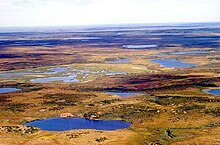North Siberian lowlands
The North Siberian Lowland is one of the eight major Russian landscapes in Siberia . It is located in the north of the Krasnoyarsk Territory and in the northwest of the Sakha Republic (Yakutia). It is located entirely north of the Arctic Circle and south of the coast of the Arctic Ocean , roughly between the mouths of the Yenisei and Olenjok . Inland, the lowlands are bounded by the Central Siberian mountains .
Geographical location
The North Siberian Lowland comprises the areas between the marginal seas of the Arctic Ocean in the north and the Central Siberian Mountains to the south - with the western Putorana Mountains and the Anabar Plateau to the east - and between the northern end of the West Siberian lowlands in the west and the Olenjok estuary in the east. The center of this area is the Taimyr Depression , which extends north of the Central Siberian Mountains and south of the Taimyr Peninsula with the Byrranga Mountains and the Taimyr Lake to the south of these mountains . The lowlands are about 1400 km long in a west-east direction, a maximum of 600 km wide and up to 300 m high in north-south direction .
Particularly in the west, the delimitation of the lowlands cannot be clearly defined because the area west of the Yenisei Gulf merges seamlessly with the northern part of the West Siberian lowlands; the northern part of the Urals on the other side of the Obbus can be seen as its extreme western boundary . In a westerly direction, the Gydan Peninsula and the Yamal Peninsula , which are separated from each other by the obbus and protrude into the Kara Sea , also belong to the North Siberian lowlands.
To the east, the lowlands meet the Arctic Laptev Sea over the Chatanga Gulf . Its extreme eastern border is beyond the Olenjek the northern part of the Czekanowskiberge , east of which the mouth of the Lena is.
geology
From a geological point of view, the lowland consists of glacial deposits of sandstone and slate . There are deposits of oil , natural gas and coal .

Landscape image
The mostly swampy lowland in the north is determined by tundra and forest tundra. In these northern regions, because of the permafrost soil, tall plants, such as trees , can hardly develop, but mosses , shrubs and ferns predominate. Larch forests are sparse further south .
Waters
Flowing waters
The two main rivers that border the North Siberian lowlands are the Yenisei in the west and the Olenjok in the east. Other rivers are (from west to east):
Still waters
In North Siberian Plain there are numerous lakes , under which Lake Taymyr is the largest. Other lakes are sorted alphabetically:
Localities
The following localities (from west to east) are located in the North Siberian lowlands:
Coordinates: 72 ° 0 ′ 0 ″ N , 101 ° 0 ′ 0 ″ E
